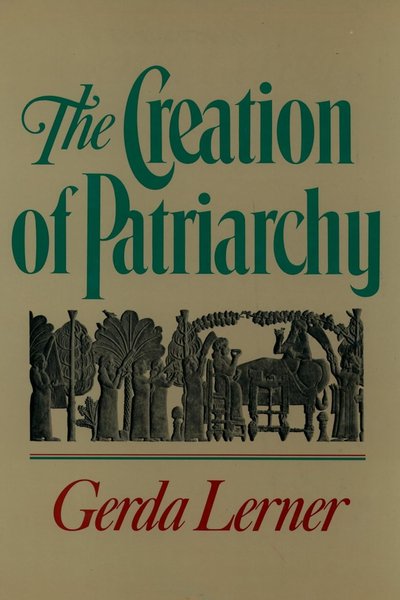The Creation of Patriarchy
Traces the origins and development of patriarchy from a historical perspective, providing crucial understanding of the historical roots of gender oppression.

📝 Book Review
“The Creation of Patriarchy” stands as a pioneering work by American historian Gerda Lerner, a milestone achievement that employs rigorous historical research methods to trace the origins and institutionalization of patriarchal systems. As an outstanding feminist historian, Lerner utilizes extensive archaeological evidence, historical documents, and cross-cultural comparative studies to present a comprehensive historical panorama of the evolution of gender relations in human society, completely overturning traditional notions about the “naturalness” of patriarchy.
At the level of historical argumentation, Lerner presents a profoundly subversive viewpoint: patriarchy is not natural or inevitable but a historical product. This assertion carries deep revolutionary significance because it directly challenges the millennia-old social consensus that views male domination as natural and inevitable. Lerner emphasizes that since patriarchy had a definite historical beginning, it must also potentially have an end. This historical perspective not only provides new frameworks for understanding the past but also offers hope and theoretical support for imagining different futures.
Through intensive historical investigation, Lerner establishes the specific temporal framework for patriarchy’s formation. Her research demonstrates that patriarchal systems gradually formed and solidified in the ancient Near East approximately between 3100 BCE and 600 BCE. This period corresponds to crucial transformation periods in human civilization, including the agricultural revolution, the rise of urban civilizations, the emergence of private property, and the establishment of state apparatus.
Lerner’s analysis reveals the intrinsic connections between patriarchy and these major social transformations, demonstrating how changes in gender relations interweave with broader socioeconomic developments. She particularly emphasizes that patriarchy’s establishment was not a sudden single event but a long gradual process spanning nearly 2,500 years. This gradual characteristic illustrates the complexity and profundity of patriarchy’s institutionalization, involving not only changes in political and economic structures but fundamental transformations in cultural ideology and social psychology.
Mechanisms of Patriarchal Control
When analyzing the key mechanisms of patriarchy’s establishment, Lerner identifies control over women’s reproductive capacity as the core of this system. She profoundly recognizes that by controlling women’s sexuality and reproduction, men not only ensured patrilineal transmission of property but, more importantly, established an entire ideological system concerning bloodline, inheritance, and family continuation.
This appropriation of women’s reproductive capacity represents not merely economic calculation but the fundamental expression of power relations, transforming women’s bodies and reproductive functions into resources and property controlled by men. Lerner’s analysis reveals how this control extends beyond individual relationships to become the foundation for broader social and economic systems.
The significance of reproductive control in Lerner’s framework extends to understanding how women’s bodies became the first form of private property, establishing patterns of ownership and control that would later be applied to other resources. This insight connects early forms of gender oppression to the development of class societies and economic inequality more broadly.
Women as Exchange Objects
Lerner’s analysis of the “exchange of women” phenomenon reveals another important mechanism in patriarchy’s establishment process. She analyzes in detail how women became “objects” to be exchanged in inter-tribal alliances, trade, and political negotiations. This exchange not only reinforced women’s subordinate status but, more importantly, established social practices that objectified women.
Through this institutionalized exchange, women were deprived of autonomous choice rights, becoming mediators and tools for men to establish social relationships. This system of exchange created networks of male alliance and cooperation while systematically excluding women from political and economic decision-making processes.
The exchange of women, as Lerner demonstrates, was crucial for establishing male solidarity across kinship groups while simultaneously creating the conditions for women’s subordination within those groups. This analysis reveals how gender oppression served broader political and economic functions in early state formation.
Role of Slavery and Class Formation
The role of slavery in patriarchy’s establishment process is another focus of Lerner’s analysis. She points out that the emergence of slavery, particularly the existence of female slaves, provided specific models and practical experience for hierarchical systems and domination relationships. Female slaves’ status embodied not only gender oppression but also the intersection of multiple oppressions, laying foundations for later more complex hierarchical systems.
Simultaneously, slavery provided ideological resources for society to rationalize unequal relationships. The normalization of human ownership and exploitation created precedents for other forms of systematic oppression, including the treatment of women as property within marriage and family structures.
Lerner’s analysis of slavery reveals how the intersection of gender and class oppression created particularly vulnerable positions for enslaved women while also demonstrating how systems of domination reinforce each other across different social categories.
Ideological Construction and Religious Transformation
At the level of ideological construction, Lerner provides in-depth analysis of the decisive role of religious transformation in patriarchy’s consolidation process. She meticulously traces how monotheism gradually replaced goddess worship and how this religious transformation reinforced patriarchal ideology. This religious transformation not only changed people’s worldviews and value systems but, more importantly, provided sacred legitimacy for male domination.
By placing male deities at the center of religious systems, patriarchy gained sacred authority transcending secular politics. Lerner’s analysis reveals how the suppression of goddess worship and female religious authority paralleled and reinforced women’s exclusion from other forms of power and leadership.
The religious transformation that Lerner documents includes not only changes in deity worship but fundamental alterations in cosmology, creation myths, and moral systems that positioned male authority as divinely ordained while casting female power as dangerous or illegitimate.
Masculine Monopolization of Symbol Systems
Lerner’s analysis of the masculinization process of symbol systems is equally profound and comprehensive. She explores how language, law, and philosophy were gradually monopolized by men, systematically excluding women from participating in meaning-creation processes. This symbolic monopoly not only limited women’s expressive capabilities but, more importantly, controlled mechanisms of social meaning production, marginalizing or completely eliminating women’s experiences and perspectives.
By controlling symbol systems, men controlled not only interpretive rights over reality but also the imaginative space for future possibilities. This analysis reveals how cultural and intellectual power serves to maintain and justify other forms of domination.
The masculinization of symbol systems that Lerner describes includes the development of written language as a male preserve, the creation of legal codes that institutionalized male authority, and the emergence of philosophical traditions that defined rationality and citizenship in explicitly masculine terms.
Systematic Bias in Historical Records
Systematic bias in historical records represents another important dimension of Lerner’s analysis. She reveals how women were systematically excluded from historical records, how their contributions were ignored, diminished, or attributed to men. This bias in historical recording not only distorted our understanding of the past but, more importantly, perpetuated and reinforced stereotypes about women’s capabilities and value.
Lerner’s work demonstrates how the exclusion of women from historical narratives serves to naturalize their exclusion from contemporary power structures, creating the illusion that male dominance has always existed and always will exist. Her methodology for recovering women’s historical agency provides models for feminist historians and challenges traditional approaches to historical research.
Women’s Complicity and Resistance
In analyzing women’s complicity and resistance, Lerner proposes the highly insightful concept of “patriarchal bargain.” This concept profoundly explains why some women support patriarchal systems that seem detrimental to them—they gain relative protection and status elevation by complying with established rules. This analysis avoids simply portraying women as passive victims while revealing the complexity of power relations and women’s rational choice strategies under constrained conditions.
The concept of patriarchal bargain illuminates how individual women might benefit from conforming to patriarchal expectations while the system as a whole continues to subordinate women as a class. This framework helps explain apparent contradictions in women’s relationship to patriarchal systems without blaming individual women for their survival strategies.
Simultaneously, Lerner emphasizes that despite systematic suppression, women have always been developing their consciousness and various forms of resistance, though these efforts are often forgotten by mainstream history. This recognition of women’s agency not only corrects historical record bias but also provides historical roots and spiritual motivation for contemporary feminist movements.
Theoretical Contributions and Framework
Lerner’s theoretical contributions are multifaceted and far-reaching. First, she provides a historical materialist analytical framework for understanding patriarchy, examining gender relations’ transformations within broader socioeconomic developmental contexts. Second, she powerfully challenges essentialist viewpoints about gender roles, using historical evidence to prove the socially constructed nature of gender relations.
Additionally, her work established important theoretical foundations and methodological guidance for feminist historiography, influencing decades of subsequent gender history research development. Lerner’s methodology demonstrates how feminist scholarship can recover lost histories while simultaneously challenging the very frameworks that created those losses.
Her integration of archaeological, anthropological, and textual evidence provides models for interdisciplinary feminist research, while her attention to cross-cultural comparison prevents the universalization of particular historical experiences.
Contemporary Significance and Implications
The contemporary significance of “The Creation of Patriarchy” lies in providing historical perspective for understanding and changing existing gender relations. Understanding patriarchy’s historical nature helps us recognize that gender equality is not only an ideal but a possible direction for historical development.
By demonstrating patriarchy’s historical construction process, Lerner’s work helps people question seemingly “natural” gender roles and hierarchical relationships, recognizing them as changeable social institutional arrangements. This historical perspective provides foundations for imagining and working toward alternative social arrangements based on equality rather than domination.
Most importantly, Lerner’s analysis reveals the fundamental possibility of transformation: since patriarchy is a historical institution created by humans, it can completely be changed, reformed, or even abolished. This recognition not only provides solid historical foundations for feminist theory but also offers hope and confidence to all practitioners committed to gender equality.
Methodological Innovation and Impact
Lerner’s methodological innovations in feminist historiography have had lasting impact on how scholars approach questions of gender and power in historical research. Her emphasis on reading historical sources “against the grain” to recover women’s experiences provides models for finding agency and resistance within seemingly totalizing systems of oppression.
Her integration of economic, political, social, and cultural analysis demonstrates the necessity of holistic approaches to understanding historical transformation, while her attention to the gradual nature of patriarchy’s development provides frameworks for understanding how large-scale social change occurs.
Global and Cross-Cultural Perspectives
While Lerner’s analysis focuses primarily on the ancient Near East, her theoretical framework has proven applicable to understanding patriarchal development in diverse cultural contexts. Her emphasis on the historical contingency of patriarchal systems provides tools for analyzing how gender relations vary across cultures while still identifying common patterns of male dominance.
The cross-cultural applicability of Lerner’s insights has influenced feminist scholars working in different geographical and temporal contexts, contributing to more nuanced understandings of how patriarchal systems adapt to different cultural and economic conditions while maintaining fundamental structures of male dominance.
Conclusion: Historical Hope for Transformation
“The Creation of Patriarchy” demonstrates that understanding the historical roots of gender oppression is essential for envisioning and creating more equitable futures. Lerner’s meticulous documentation of patriarchy’s historical development reveals both the depth of the challenges facing those working for gender equality and the fundamental possibility of transformation.
Through her rigorous historical analysis, Lerner provides not only a critique of patriarchal systems but also hope for their transformation. Her work reminds us that history is not destiny, and that the future is full of possibilities for recreating more equitable social relationships. The historical perspective that Lerner provides continues to inspire feminist scholars and activists by demonstrating that what has been historically constructed can be historically reconstructed.
Her lasting contribution lies in establishing that patriarchy, despite its apparent naturalness and universality, is a human creation that can be unmade through human action. This insight provides the theoretical foundation for all subsequent feminist work aimed at creating more just and equitable societies, demonstrating that the struggle for gender equality is not only morally necessary but historically feasible.
Discussion
读书讨论
分享您对这本书的感想和看法,与其他读者交流见解
加入讨论
分享您对这本书的感想和看法,与其他读者交流见解
加载评论中...
Book Info
Related Topics
🛒 Get This Book
 Buy on Amazon
Buy on Amazon Related Books
读书讨论
分享您对这本书的感想和看法,与其他读者交流见解
加入讨论
分享您对这本书的感想和看法,与其他读者交流见解
加载评论中...

